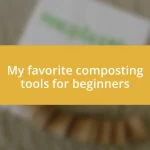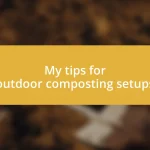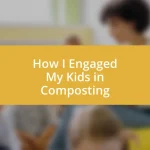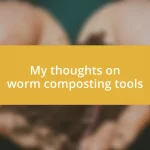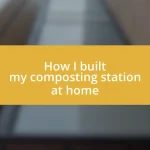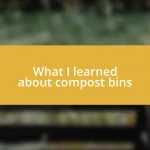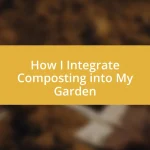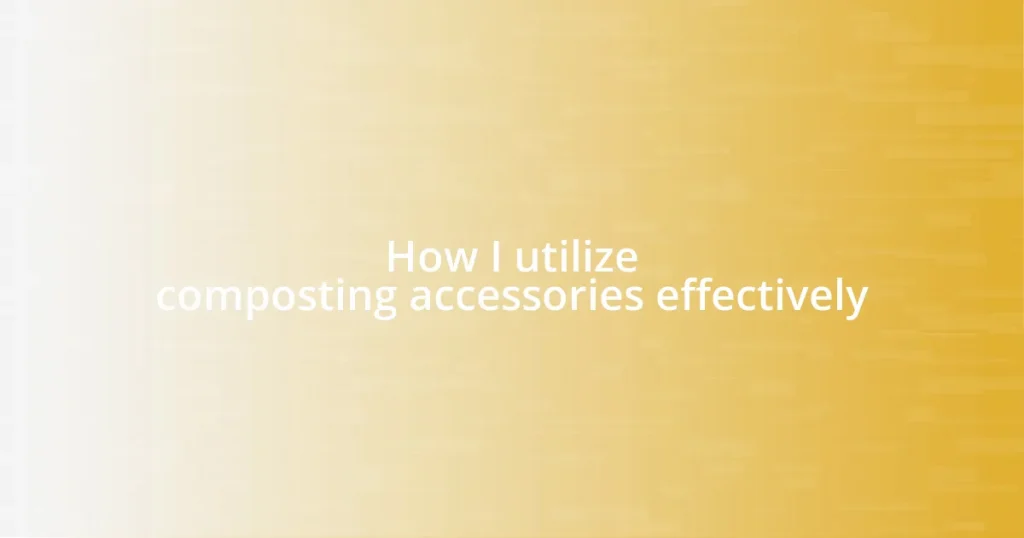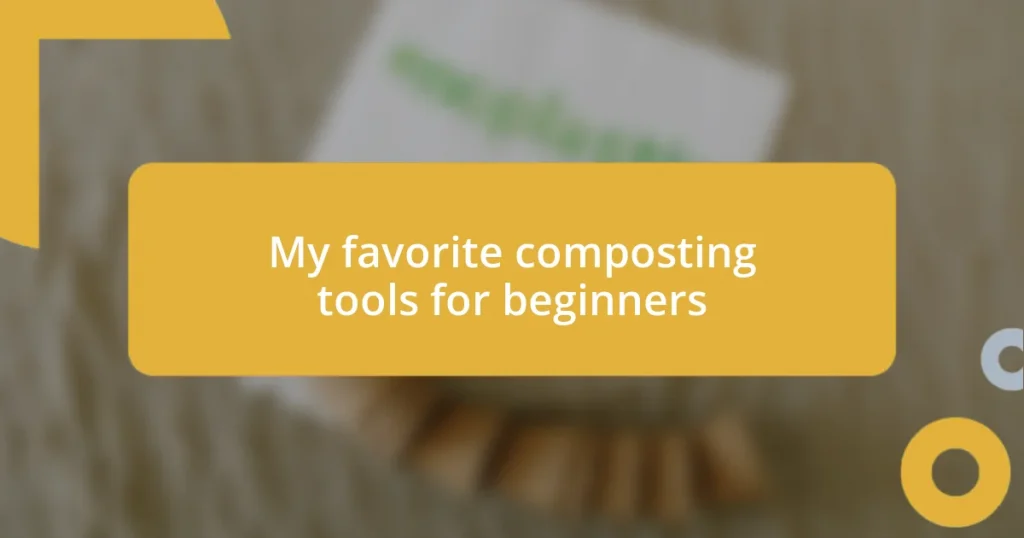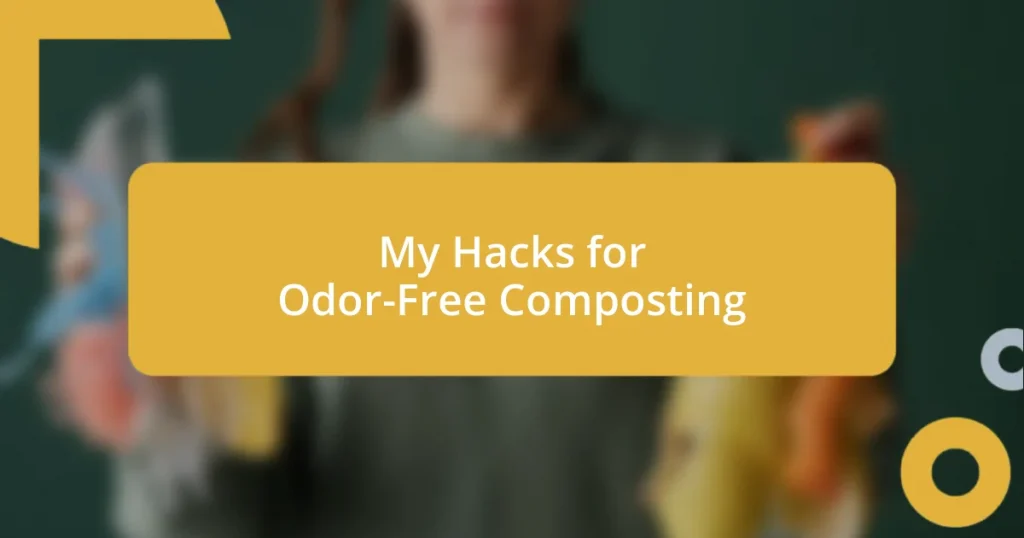Key takeaways:
- Balance between green (nitrogen-rich) and brown (carbon-rich) materials is essential for healthy compost—aim for a ratio of three parts brown to one part green.
- Choose a manageable compost bin size based on your space and waste production; larger bins may become unmanageable for beginners.
- Regular maintenance, including aeration and moisture control, is crucial for a successful composting process, turning it into a nurturing, rewarding experience.

Choosing the right compost materials
When I first began my composting journey, I was excited yet overwhelmed by the choices available. I remember standing in my kitchen, wondering if those leftover vegetable peels would really make a difference. It turns out, yes! Green materials—like those peels—are rich in nitrogen and essential for creating healthy compost.
As I explored further, I realized that balance is key. I found myself collecting brown materials like dried leaves and cardboard, and what a transformation it created! If I had known earlier that you need roughly three parts brown materials to one part green materials, I could have saved some initial frustration. Isn’t it fascinating how nature works in harmony?
Don’t forget about what you shouldn’t put in your compost! After a mishap with some moldy bread, I learned that dairy and meat can attract pests and create odors. It’s moments like these that make you appreciate the simplicity of composting—just combine the right materials and watch the magic unfold! What have you tossed away in the past that could have enriched your compost?

Planning the compost bin size
When planning the size of your compost bin, consider not just your available space, but also how much organic waste you realistically produce. I remember estimating my kitchen scraps and yard waste, and I found myself pleasantly surprised at just how much small items like banana peels and grass clippings added up. A good rule of thumb is to start with a bin that holds at least one cubic yard if you’re a family of four or more looking to compost regularly.
Next, think about the frequency of your composting. In the beginning, my bin felt quite empty, as I was still figuring out my routine. I discovered that a smaller bin could work for a beginner because it encouraged me to pay closer attention to my waste and composting practice. However, if you want to expand your composting efforts later on, scaling up can definitely help manage a larger waste volume, especially during peak gardening seasons.
Lastly, remember that bigger isn’t always better. During my first summer, I created a massive 4-foot-by-4-foot bin, but I quickly realized it was challenging to turn and manage. I often think back to that time; if I had chosen a more manageable size, I could have enjoyed the process without feeling overwhelmed. The goal is to find a size that fits both your lifestyle and your gardening aspirations.
| Bin Size | Typical Use |
|---|---|
| Small (1ft x 1ft) | Great for apartment dwellers or those with limited waste |
| Medium (3ft x 3ft) | Ideal for families or small gardens with regular compost needs |
| Large (4ft x 4ft) | Best for avid gardeners and those with significant yard waste |

Selecting the ideal location
Choosing the perfect spot for your compost bin was a journey for me. Initially, I placed mine in a corner of my yard that I thought was convenient. But I quickly realized that I rarely visited that spot, leading to a missed opportunity for turning those scraps into black gold! Ideally, you want to locate your bin where it’s easily accessible. You’ll want to keep it close to your kitchen for ease of dumping in your kitchen scraps and near your garden for quick access when you’re ready to spread that rich compost.
Here are a few crucial factors to consider when selecting the ideal location for your compost bin:
- Sunlight: A sunny spot can help keep the composting process warm and accelerate decomposition, but too much sun can dry it out as well.
- Drainage: Ensure the area has good drainage; I learned the hard way when my first bin became a soggy mess after a rainstorm because it was placed on a low patch of lawn.
- Proximity to Garden: Place your bin within easy reach of where you’ll use your compost. This makes it easier to incorporate into your gardening routine.
- Ventilation: Good airflow is essential for healthy compost. I noticed that my bin worked much better when there was a bit of space around it, allowing fresh air to circulate.
Composting has become part of my daily rhythm, and it’s ingrained in my routine now. It’s those little decisions about location that make a world of difference when it comes to the joy of composting.

Constructing the compost bin
Building my compost bin was a bit of an adventure. After settling on a size, I realized that constructing the bin itself was equally important. I opted for wooden pallets, which not only saved me money but also felt like a sustainable choice. The first time I saw those pallets come together, I was thrilled. It felt as if I’d taken a tangible step toward reducing my waste and nurturing my plants at the same time.
While constructing the bin, I found that using screws instead of nails made a significant difference in durability. I vividly remember the first rainy day after I built it—the rain poured down but my bin stood firm. It was a great feeling to see everything holding together. If you’re considering materials, think about what you have on hand. Recycling old wood or even using wire mesh can create an effective bin. I always emphasize practicality; you want it functional and easy to maintain.
As I finished assembling the bin, I stood back and noticed how the design allowed for airflow, which is crucial for decomposition. The little gaps I left between the slats, driven by their playful design, turned out to be wise choices. Reflecting on that day, I could see it wasn’t just about holding compost but creating a system that felt alive. Were those simple choices the foundation of my successful composting journey? Absolutely! Those thoughtful details made my first composting experience both rewarding and enjoyable.

Maintaining the compost bin
Maintaining my compost bin became a labor of love. Initially, I was daunted by the thought of managing the heap, but with a simple routine, I learned to enjoy the process. I vividly remember the first time I turned the compost; the rich, earthy smell was intoxicating! It felt like I was unlocking nature’s secrets right in my backyard. Regularly aerating the compost with a pitchfork or even my garden spade made a world of difference. It not only helped aerate the material but also gave me a reason to check on my little ecosystem.
Keeping an eye on moisture levels is crucial, too. I learned the importance of a balanced mix of greens (like vegetable peels) and browns (such as dried leaves). One rainy afternoon, I realized my compost was too wet, transforming it into a mushy mess that stank rather than smelled sweet. By adding more dried materials and turning it regularly, I could restore that balance. Does it really make that much difference? Absolutely! When I found the right mix, everything just clicked, and the worms began to thrive, which is a wonderful sign of healthy compost!
I also discovered that patience is key in maintaining a compost bin. I remember a particularly busy week when I neglected it. Returning to find everything collapsed made me feel a touch defeated. But I shrugged it off, realizing that composting is not just about the end product; it’s a journey. Every handful of compost is a lesson, and the process truly becomes part of my gardening routine. So, what have I learned? Maintaining a compost bin isn’t just about keeping it tidy—it’s about nurturing a living thing, one that rewards you with incredible soil in return.

Troubleshooting common composting issues
When I first started composting, I faced a surprising array of common issues. I’ll never forget the moment I discovered my compost heap was too compacted. It felt like a slap in the face! I had been diligent about maintaining my pile, yet it had transformed into a dense brick. I quickly learned that not only did I have to aerate it regularly, but I also needed to mix in some coarse materials like straw or wood chips to keep air flowing. Have you ever felt like you were doing everything right only to hit a wall? It’s frustrating, but it’s all part of the learning curve.
Then there was the pest issue. Initially, I was horrified to find fruit flies buzzing around my compost. My first thought was, “What did I do wrong?” It turned out, I was adding too many kitchen scraps without burying them. Once I started to dig those scraps into the middle of the pile, the flies vanished, and I felt a wave of relief wash over me. It’s funny how such simple adjustments can make a world of difference; every problem can be tackled if you stay observant and act swiftly.
Sometimes, the smell of my compost would change unexpectedly, which was another wake-up call. I remember standing in front of my bin, nose crinkled at the overwhelming odor wafting up. It was an eye-opener. I realized I wasn’t balancing the greens and browns, resulting in a smelly “soup.” Since that experience, I’ve taken to periodically checking on the smell, ensuring it has that pleasant earthy aroma. Have you ever caught a whiff of something that steered you back in the right direction? It’s all about tuning in to the signals your compost gives you; it can guide your hand and make your composting experience much smoother.

Using finished compost effectively
Using finished compost effectively can transform your gardening experience. I still remember the first time I spread my homemade compost across my vegetable garden. I felt a mix of excitement and pride, knowing I was nourishing my plants with something I created. Watching them flourish in the weeks that followed was nothing short of magical. Have you ever witnessed such growth from your labor? It feels rewarding, almost like receiving a gift for your hard work.
When using finished compost, understanding the right application is crucial. I often sprinkle a layer on my garden beds before planting, creating a nutrient-rich environment for seedlings. Once, I planted tomatoes right after adding compost, and the difference was stunning. They grew vigorously, and the fruits had a depth of flavor that took me by surprise. It’s like giving your plants a special treat—one that they truly appreciate.
Don’t underestimate the power of finished compost as a top dressing, either! I sometimes use it to boost the soil’s health around established plants. After a long, hot summer, I applied a layer of compost around my weary-looking perennials. The revival was remarkable; they stood taller and bloomed brighter. That moment made me realize how much our plants yearn for that enriched support. If you’ve ever seen your garden bounce back like that, you know how fulfilling it can be—your efforts really do pay off!

